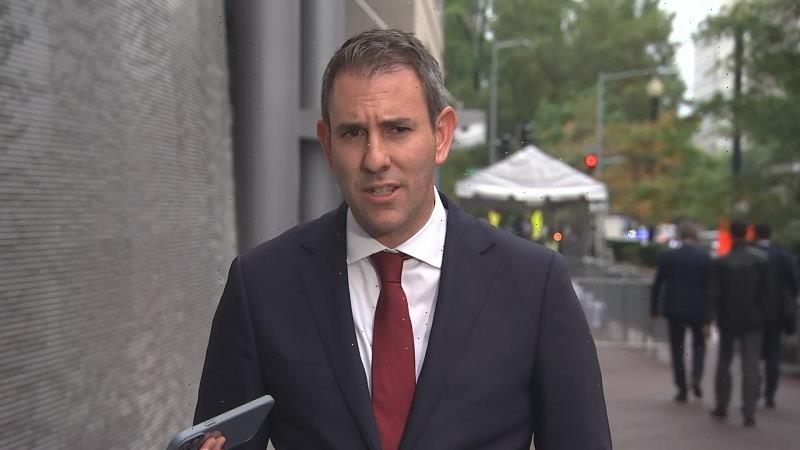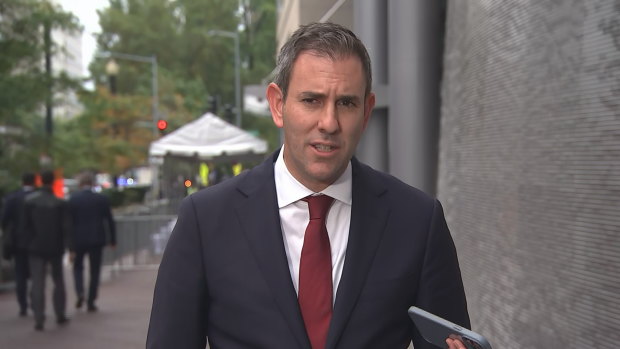Washington: Treasurer Jim Chalmers has compared the waste in the federal budget he inherited to “barnacles on a ship” that he must remove as he seeks to cut spending enough to accommodate Labor’s pre-election promises without adding to economy-wide inflation pressures.
Admitting key forecasts in the October 25 budget will change because of the challenging conditions afflicting the global economy, Chalmers revealed that politically contentious spending cuts would be unveiled later this month to make space for social investments that would be valued by voters.
Treasurer Jim Chalmers has been in Washington this week for talks with Federal Reserve chair Jerome Powell, Treasury Secretary Janet Yellen and other global financial leaders.Credit:Nine
Labor went to the May federal election promising spending cuts worth less than $1.3 billion. It has since started an audit of a suite of discretionary funds put in place by the Coalition as well as infrastructure projects that were pledged by the former government ahead of the poll.
Chalmers, who has been in Washington this week for talks with Federal Reserve chair Jerome Powell, Treasury Secretary Janet Yellen and other global financial leaders, said the budget was being held back by much of the extra spending put in place by the Coalition.
“The rorts and waste in the budget have been like barnacles on a ship and we need to scrape them off,” he told this masthead.
“The best place to start are some of these discretionary funds which have been rorted by Coalition ministers over a long period of time and there is a multibillion-dollar opportunity to start unwinding this culture of largesse in grant programs, which has dominated the budget for too long.”
The barnacle reference echoes comments made by then prime minister Tony Abbott in November 2014, when he described the scrapping of various programs as a “barnacle-scraping exercise”.
Chalmers is in the United States for the autumn meeting of the International Monetary Fund, central bankers and finance ministers from around the globe.
It comes as the economy goes through its third major upheaval in the past 15 years, following the global financial crisis of 2008 and the 2020 worldwide COVID-19 recession. This year, the IMF talks have been dominated by concerns about the aggressive increases in interest rates by central banks as they seek to tame the sharpest lift in inflation in a generation.
Financial markets now expect the Federal Reserve will lift America’s key interest rate another 1.5 percentage points to 4.5-4.75 per cent by Christmas after data on Friday showed US inflation rising to a higher than expected 8.2 per cent in September. Core US inflation reached 6.6 per cent, its highest level since 1982.
Inflation in Australia is running at its highest rate since 1990 and is expected to peak around 7.75 per cent by year’s end.
Chalmers, who has confirmed this month’s budget will not show any surpluses over the next four years, said he was focused on ensuring the government’s election promises were delivered while not adding to inflationary pressures in the economy.
“I think in some areas where we are trimming spending or reprofiling spending, it will be seen as a series of difficult decisions taken in difficult times,” he said.
“Our intention is to make room for some of this necessary spending in areas like health and aged care and the NDIS and defence.
“[There] are the things we want to be investing in – in order to do that effectively, you need to make room somewhere in the budget.”
The government’s single largest cut promised in the election was a $3 billion reduction in spending on outside consultants. It is expected to save $500 million this financial year alone.
The timing of certain infrastructure projects is also likely to be changed. Labor promised to slow down the contentious Hells Gates dam in Far North Queensland by one year but other “smoothing” of projects is expected to be confirmed on budget night.
A growing risk is the government’s large holding of debt, which reached $892.3 billion on Friday. Another $3.5 billion in debt is scheduled to be sold next week.
Interest on debt is the fastest-growing expenditure within the budget, which is expected to show this item climbing by 14.4 per cent a year over the next four years.
In the March budget, handed down by then-treasurer Josh Frydenberg, a deficit of $78 billion was forecast for 2022-23. Deloitte Access Economics this week forecast the deficit to be closer to $61 billion.
AMP Capital chief economist Shane Oliver, who is expecting a further crackdown on tax avoidance to help improve the bottom line, said Labor’s pre-election promises of off-budget spending could add to inflationary pressures.
“Of interest will be whether the government goes ahead with its $52 billion in off-budget funds, including the $10 billion Housing Australia Fund, as it adds to public borrowing and upwards pressure on interest rates,” he said.
“A revenue windfall – partly due to higher inflation – will likely allow lower budget deficits than projected in March but the projections are still unlikely to show a surplus due to spending pressures and lower real growth assumptions.”
Cut through the noise of federal politics with news, views and expert analysis from Jacqueline Maley. Subscribers can sign up to our weekly Inside Politics newsletter here.
Most Viewed in Politics
From our partners
Source: Read Full Article

